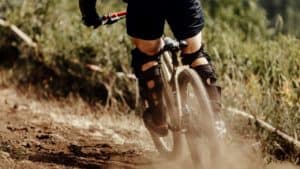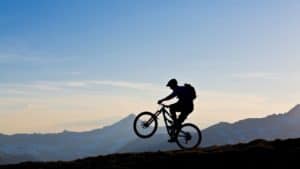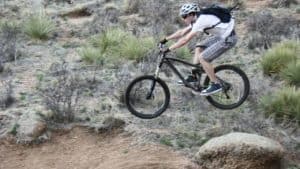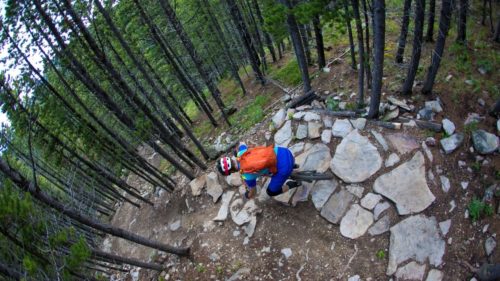Mountain biking can be one of the most enjoyable ways to go off-road and tackle different types of trails. It seems like every rider who starts to go off-road for the first time really starts to see the fun and enjoyment it brings.
For people starting out, mountain biking might seem a little intimidating. Going on the very flat and smooth ground is one thing, but hills and rough terrain or another.
What skills do you need for mountain biking? The best skills you need to master to mountain bike efficiently are proper body position, effective braking, climbing efficiently, descending with precision to avoid a crash. You also need to master cornering at fast speeds.
We know that not everyone is coming out with a ton of experience. The good news is that there is a lot of fun to be had regardless of skill level when it comes to mountain biking.
1. Looking Ahead

A successful mountain bike rider will always have the ability to look ahead when they need to. This is to start planning for any potential moves or to slow down when necessary.
Having a sense of what lies ahead can keep a rider safe as they also push the pace.
One of the biggest signs of a beginner on a mountain bike is someone constantly trying to push the pace, only to be in vulnerable positions more often than not.
Don’t be a reckless mountain bike rider, or it will be a very hard and painful lesson. Looking ahead and having a plan well in advance will prevent any need for sudden movements.
2. Balance
Think back to the first time riding any type of bike. Balance is a key part of success, and it never goes away. People take keeping balance for granted on pretty easy rides, but what about mountain biking?
Balance is constantly being tested, and successful riders will know how to contort their body in the right ways to always be as balanced as possible.
Try to make sure that the body is controlling the bike, not the other way around. Too many people will get in the habit of not taking control with balance and riding in general.
Having the right amount of balance on new types of terrain takes practice more than anything.
3. Pedaling

As straightforward as pedaling might seem, it’s an important part of having success as a mountain bike rider.
Not only does pedaling need to be efficient, but riders need to be able to build up their strength to take on more challenging trails all the time. The stronger a person is pedaling, the longer they can go.
By being efficient with pedal strokes, riders save energy throughout the ride. That means climbing smoothly, sprinting with power when necessary, and even coasting from time to time.
There are strategic ways to save energy as much as possible, and a lot of it comes down to proper pedal strokes. To get the proper pedal stroke, make sure that the saddle is at the right height to help out as much as possible.
Of course, it doesn’t matter where the saddle is if the bike is not the right size. Make sure to do the measurements when purchasing a brand new bike to ensure that only slight adjustments are necessary.
There are many ways to fine-tune a bike, but taking it to an entirely different size is challenging.
4. Cornering
Mountain bike riding doesn’t seem too complicated at first, especially going in a straight line. However, cornering is where a lot of riders will face their first challenge.
Those who want to go faster and more smoothly overall will need to master the art of cornering, as it involves a little bit of everything to get it just right.
The first step is being able to shift the body in the right ways. Going about cornering the wrong way is going to almost automatically set someone up for failure.
Lean into some turns, while leaning a little bit to the side for others. That will offer the most amount of flexibility to get the job done.
It might seem like slowing down is the way to go when cornering, but it’s actually better to pick up a bit more speed through the turns to not only get through the challenge but take some time off the total amount of speed.
It really comes down to a lot of repetition when cornering. Some people get it down pretty quickly, while others will need to work on it as time goes on.
The good news is that cornering isn’t as intimidating as some people make it out to be. Once a person realizes the type of bike they are working with and how it handles certain situations, it becomes second nature for a lot of riders.
5. Lifting The Front Wheel

Mountain bike riders who want to avoid certain situations will need to learn how to lift the front wheel from time to time. It might not come up that much, but being able to do so pretty easily will lead to quite a bit of success.
The key here is to know how to put weight on the back of the bike, then pull up the front part. It can feel impossible when the weight is not distributed properly, which is why being able to move the body around a bit on the bike is part of the process.
The reason why a front-wheel lift makes sense is to get over things that might not be so easy to roll over. It also can be useful for pulling off tricks later on, but most people are just trying to master the basics at first.
Keep in mind that when first learning, the front wheel lift will not be too big. With that said, people will be shocked to see just how little of a jump it actually ends up being.
It’s better to jump very quickly at first so that there’s no sense of losing control of the bike in general. When going too high in the air, there can be some instability.
6. Efficient Climbs On Tough Terrain
During a ride, every mountain bike rider will need to learn how to tackle the toughest climbs. It’s one thing to take a little bit of an incline, but what about something that is steep and a little bit technical?
Having technical climbing skills is necessary to take things to the next level. One of the biggest keys to success with technical climbs is to have the seat height in the right position.
Some people actually will adjust the seat height before they take on a tough climb. Others will just get out of the saddle and try to pedal that way. Whatever works for an individual is going to be something great to build off of going forward.
It’s fine not to be amazing at climbing steep hills in the beginning. In fact, beginners might feel more comfortable just dismounting and walking a bike up the hill.
It’s frustrating, to say the least, but a move that makes better sense than completely being overwhelmed.
7. Drops

Other obstacles found on trails include drops, such as stair steps. A small jump can be a great way to learn how to handle all types, and people can practice more and more.
Everyone has their own unique type of approach to riding a drop. There is a way to do a brief manual, or a pump and lean technique. Trying out a few of the basics will allow people to understand what works for them.
The very first time a rider pulls off a successful drop, it might seem like a crazy trick. In time, it becomes second nature. Trails are unpredictable, and even an average setup is likely to have a drop or two for those riders out there to tackle.
At least have some of the basics down to avoid being in a vulnerable situation.
All of the skills above are pretty basic for beginners to get down so that they can enjoy riding.
At some point, riders want to get even better at doing different types of skills, which is why these advanced skills are worth practicing from time to time.
It’s not going to be something learned perfectly overnight, but it gets easier as time goes on.
8. Descending Fast
Descending at a very fast speed usually means that it’s a steep decline in general. It’s exhilarating to pick up speed like that, but not everyone is considered comfortable from the beginning on a mountain bike.
The goal here is to not only stay safe and on the bike, but use a decline as an advantage overall. Too many people fight against descending quickly, which is not going to help out with speed on straightaways.
9. Intricate Jumps
Lifting the front wheel is one thing, but what about actually jumping while on a mountain bike ride? Believe it or not, it can be done by even those riders starting out at a relatively modest level.
Jumps include a lot of practice, but people start to get the technique down as time goes on.
Don’t try to do anything too crazy at first, as it’s a recipe for disaster. Jumping practice can happen off of a trail, which is usually better to have a more controlled environment.
Why Basic Skills Matter in Mountain Biking
Whether it be nose pivots, wheelies, skinnies, or any other practical tricks, it makes sense for mountain bike riders to start practicing them eventually. Yes, they are technical tricks, but they come in use during normal riding as well.
They are not necessary to get out there and ride the first time, but most should learn them to feel a little more comfortable overall.
Mountain biking is challenging at first, and it only gets more challenging with tougher trails out there. A lot of people love the sport, and learning the skills makes it that much better.

